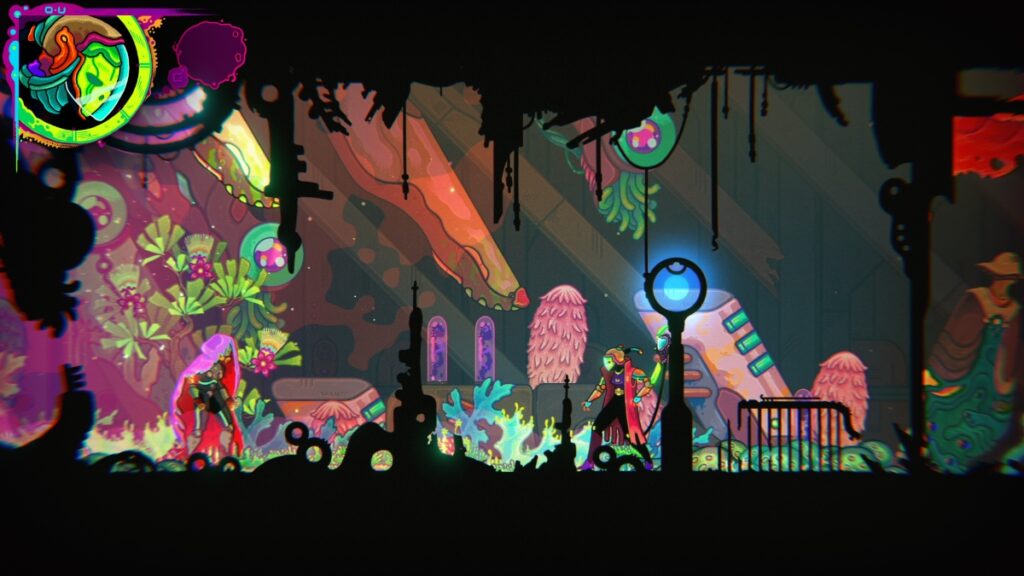Skip To...
If you play Ultros expecting just another drab and dreary Metroidvania, you’re in for a shock. It has the visual stylings of a ’70s blacklight poster, but the gameplay is katana-sharp. You control Ouji, a silent wanderer who seemingly crashed her ship into one of the strangest worlds I’ve ever encountered in the genre. What follows is a balance of rhythmic action, thoughtful exploration, and bizarre organ harvesting. Explore, kill, snack, and grow in strength, enabling even deeper exploration. It’s a gameplay loop that’s just as hypnotic as the game’s unforgettable visual style. Whether you’re a fan of Hollow Knight or the genre’s classics, Ultros serves up a dish your tastebuds will thank you for.
The Weird Wide World of Ultros

Ultros takes place in The Sarcophagus, a cosmic uterus holding a demonic being. Yes, you read that right. The first thing you’ll notice about The Sarcophagus, and Ultros in general, is its striking art style. It’s common for a Metroidvania to lean more toward Castlevania than Super Metroid visually: bleak castles and catacombs covered in blood and cobwebs are almost the standard. Ultros takes the opposite path, embracing vibrant colors and forms inspired by fungi and other natural phenomena. It’s like drowning inside a lava lamp, which might not sound like a compliment but is. If you’re getting Hotline Miami vibes from the scream-in-your-face color palette, it’s no accident. Both games are the artistic brainchildren of El Huervo.
Art isn’t the only area in which the game delivers an atypical experience. The story sets its sights high, exploring deep themes and packing in surprises to keep players engaged. Though the protagonist Ouji is silent, characters like Wallet and Gärdner help sell the narrative one bizarre line of dialog at a time.
A compelling story isn’t enough if a Metroidvania lacks satisfying exploration. Thankfully, Ultros does exploration better than most games. Even in just the first few hours, The Sarcophagus proves to be a fascinating setting, consistently rewarding you for venturing off the beaten path. You won’t just be killing as you venture the psychedelic landscape: you’ll also be tending gardens throughout, and your green thumb is tied to exploration in fascinating ways.
The Art of Destruction

Combat in Ultros has the bones of other Metroidvanias, but builds upon it in ways that set it apart. Unsurprisingly, given the game’s aesthetic and attention to detail, combat is stylish. Jumps, dodges, and sword slashes all look great, and hits feel appropriately weighty. You can use a blend of standard and charged attacks, and as you level up you gain access to a variety of other moves. Fitting new moves into your combos feels natural, and the game has a decent difficulty curve. It’s not easy, but at least it gives you time to learn the basics before complicating things with new moves, enemy types, and more.
Related:
Hollow Knight: Charms GuideIn an excellent design decision, Ultros rewards you for executing varied combos rather than just spamming the same attack. Though you can thoughtlessly button mash your way through many encounters, doing so butchers your target. That reduces what could have been valuable resources to a bloody pulp. It’s an elegant way of encouraging the player to interact with more of the game’s systems, pick clever and creative attack patterns over dull and repetitive ones, and treat the player to more of the game’s exquisite animations than they would otherwise see.
Delectable Upgrades

If you want to level up in Ultros, you’ll need an empty stomach. Slicing your enemies up not only kills them but also turns them into resources that you can consume. Each meal is rated in terms of nutrient content, increasing one or more nutrient categories. When you’ve consumed enough nutrients of a given type, you can trade the points in to unlock new abilities. It’s weird, gross, and fits Ultros perfectly. Best of all, this mechanic ties in with combat. The more creativity and variation you bring to your combos, the higher the quality of the meal and the more nutrients you’ll receive.
Jumping back into the loop-based gameplay for just one more round is almost mandatory when everything feels this smooth. From its exquisite soundtrack and aesthetic to its quirky worldbuilding and intriguing gardening mechanic, Ultros moves Metroidvanias in a welcome new direction. It’s the kind of game that could become a classic, whether or not the word “cult” gets applied in front of it first. Maybe it’ll even get the Castlevania treatment down the line.
Ultros is scheduled to launch for PC, PlayStation 4, and PlayStation 5 on Feb. 13, 2024.







